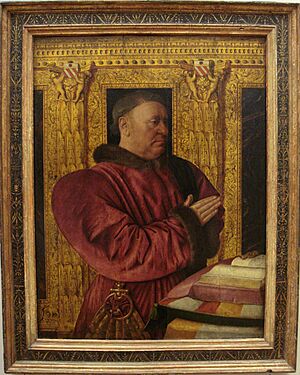Chancellor of France facts for kids

The Chancellor of France (French: Chancelier de France) was a very important official in the old Kingdom of France. You could think of them as the king's main legal advisor and the head of the country's justice system. They were also sometimes called the Grand Chancellor or Lord Chancellor.
The Chancellor's main job was to make sure that all the king's new laws and decisions, called royal decrees, were officially recorded. These records were kept by special courts across France called parlements. Since the Chancellor was appointed for life, they might sometimes be unable to do their job, perhaps due to illness or if they lost the king's favor. In such cases, their duties would be handled by their assistant, the Keeper of the Seals of France (Garde des sceaux de France). This person was responsible for the official royal seals used to make documents valid.
The last Chancellor died in 1790, right in the middle of the French Revolution. Because of the revolution, no new Chancellor was appointed. Instead, in 1791, the Keeper of the Seals took over all the Chancellor's duties. This person was then given a new title: Minister of Justice. After the kings returned to power in 1814 (this was called the Bourbon Restoration), the Chancellor's role changed. It was no longer about justice. Instead, the Chancellor became the leader of the Chamber of Peers, which was like the upper house of the French parliament, until 1848. The very last Chancellor was Etienne-Denis Pasquier, who was appointed in 1837 by King Louis Philippe I.
Contents
Early Chancellors in France
The role of a chief royal secretary or legal officer existed very early in French history. Even under the Merovingian and Carolingian kings, there were officials who performed similar duties. These early officials were often called "référendaires."
For example, during the time of Pepin the Short, who was king before Charlemagne, a person named Fulrad served as chancellor. Later, Alcuin, a famous scholar, was chancellor to Charlemagne himself. These early chancellors helped the kings manage their kingdoms and prepare important documents.
Chancellors of the Kingdom of France
Over many centuries, many individuals held the important position of Chancellor of France. They were key figures in the government, helping the kings rule and manage the country's legal system. The role was often held by bishops or other important religious figures, as well as knights and legal experts.
Here are some examples of Chancellors and when they served:
| Chancellor | Began | Ended |
| Renaud de Vendôme, Bishop of Paris | 989 | 991 |
| Gerbert d'Aurillac, later Pope Sylvester II | 991 | 998 |
| Guérin, monk and Bishop of Senlis | 1203 | 1227 |
| Pierre Flote, knight | 1297 | 1302 |
| Guillaume de Nogaret, knight | 1307 | 1310 |
| Pierre d'Orgemont (First President of the Parlement of Paris) | 20 November 1373 | 1380 |
| Guillaume Jouvenel des Ursins | 1445 | 1461 |
| Antoine Duprat, Cardinal, Archbishop of Sens | 1515 | 1535 |
| Michel de l'Hôpital | 1560 | 1573 |
| Pierre Séguier | 19 December 1635 | 28 January 1672 |
| Henri François d'Aguesseau | 3 February 1717 | 27 October 1750 |
| René Nicolas de Maupeou | 16 September 1768 | 1 July 1790 |
Keepers of the Seals
The Keeper of the Seals was a very important assistant to the Chancellor. They were in charge of the official seals that were pressed into wax to make royal documents official and legal. Sometimes, when the Chancellor was unavailable, the Keeper of the Seals would take over their duties.
Here are some of the Keepers of the Seals:
| Keeper of the Seals | Began | Ended |
| Louis Phélypeaux, Comte de Pontchartrain | 5 September 1699 | 1 July 1714 |
| Henri François d'Aguesseau | 3 February 1717 | 28 January 1718 |
| Germain Louis Chauvelin | 23 August 1727 | 20 February 1737 |
| René Nicolas Charles Augustin de Maupeou | 18 September 1768 | 24 August 1774 |
| Jérôme Champion de Cicé | 4 August 1789 | 21 November 1790 |
See also
- Royal household under the Merovingians and Carolingians

